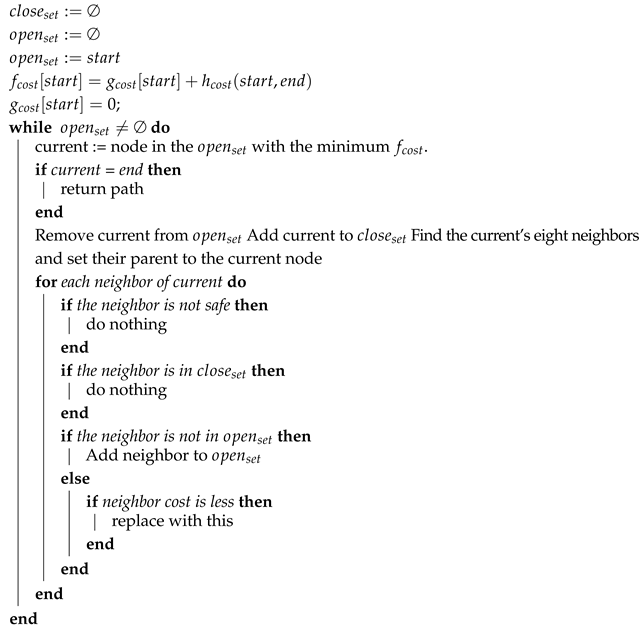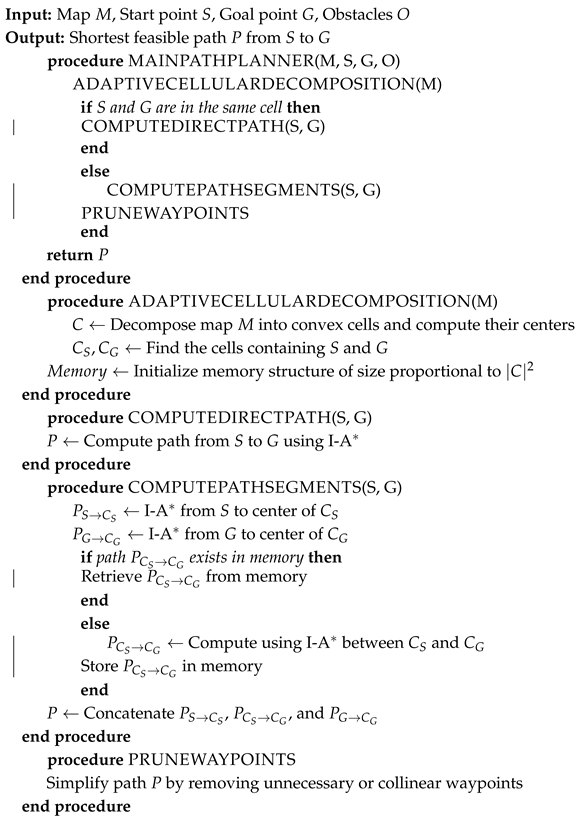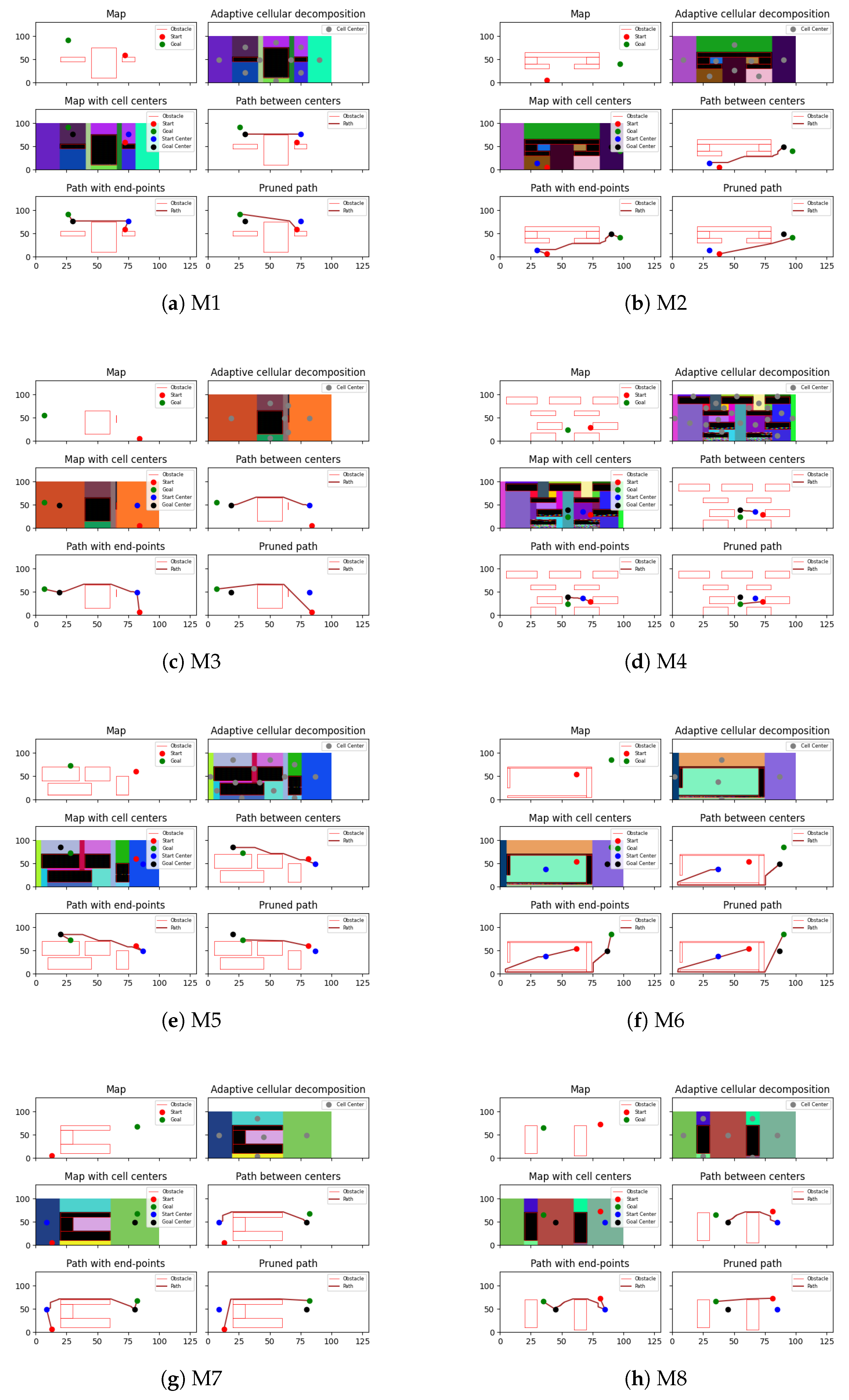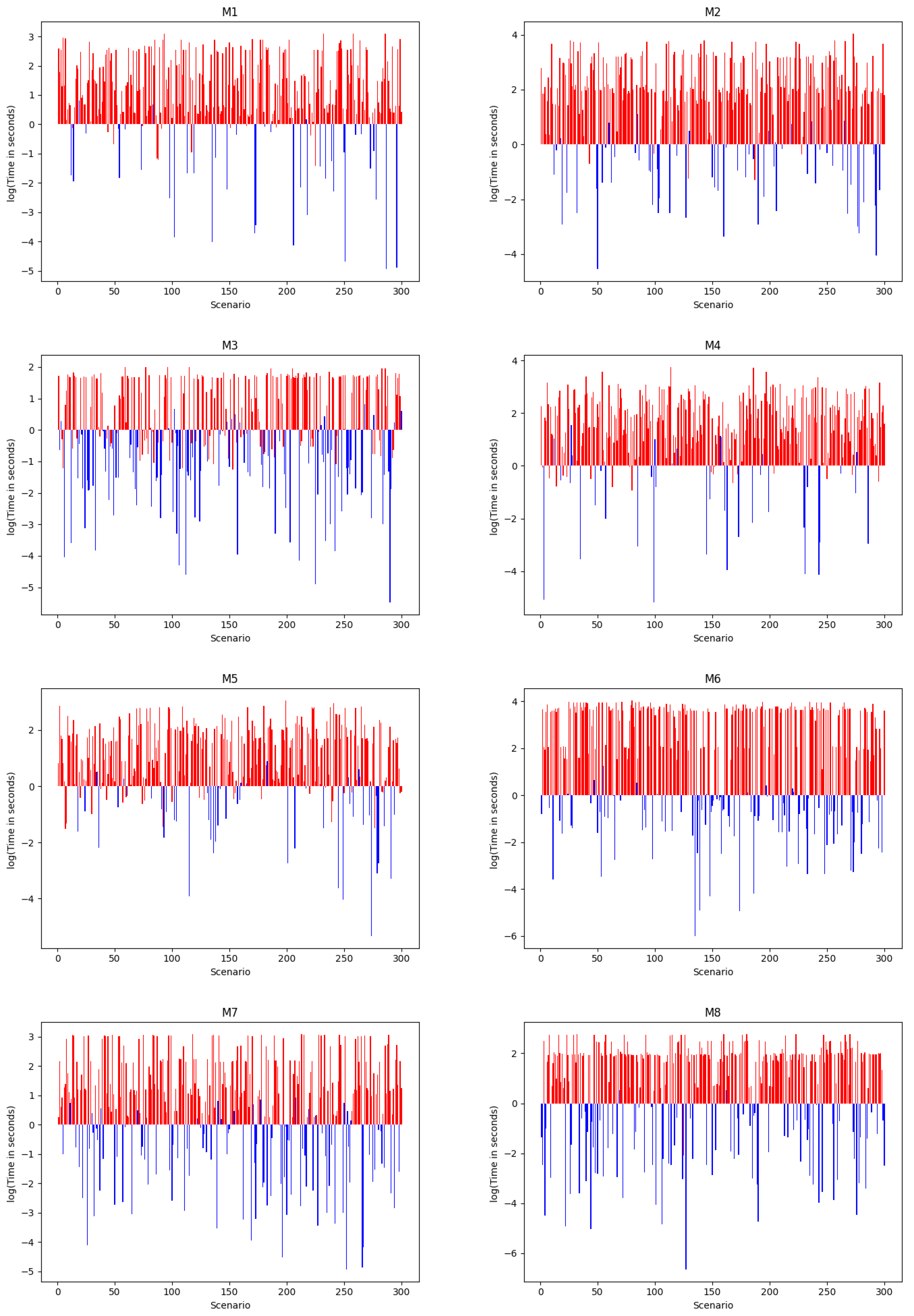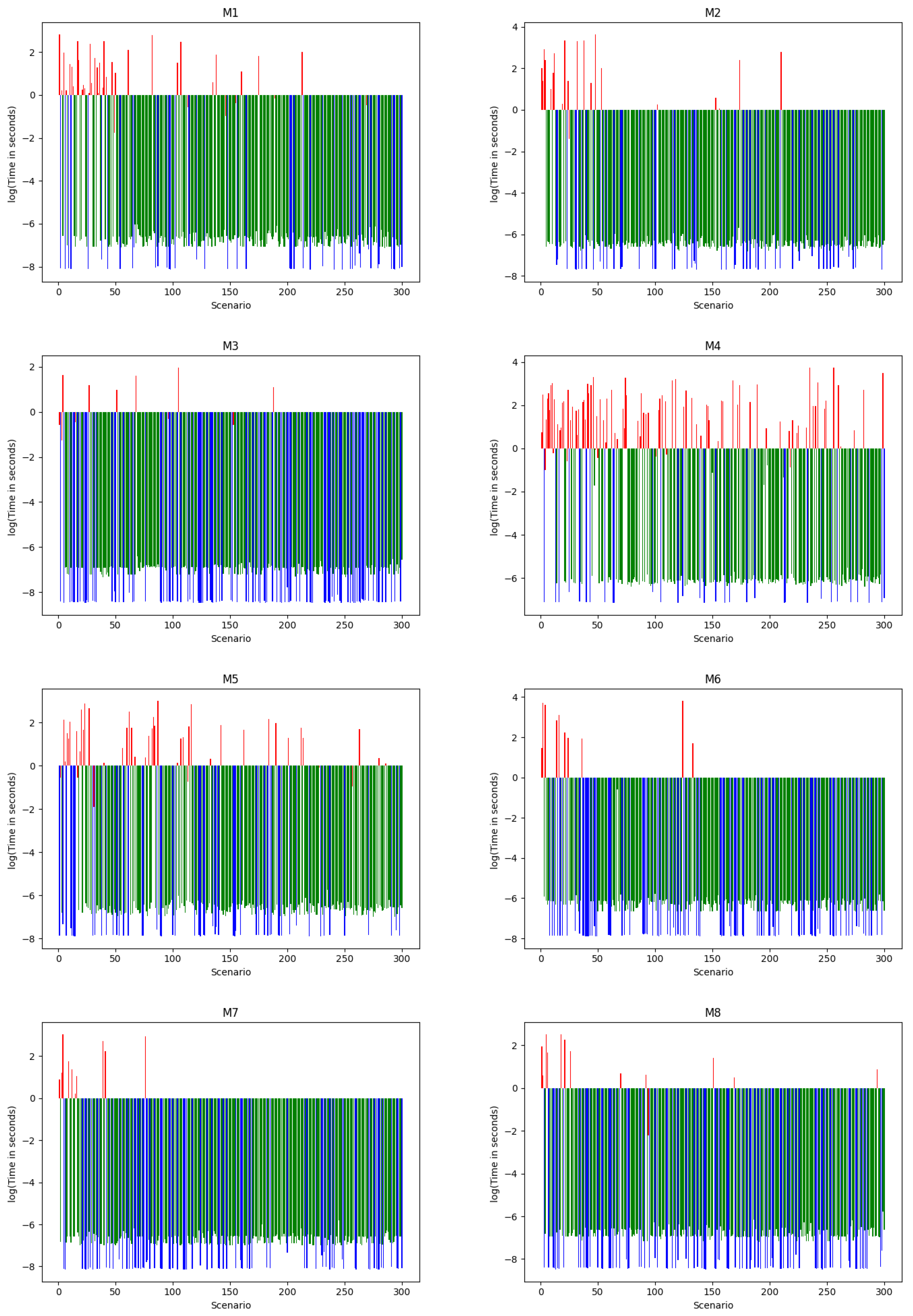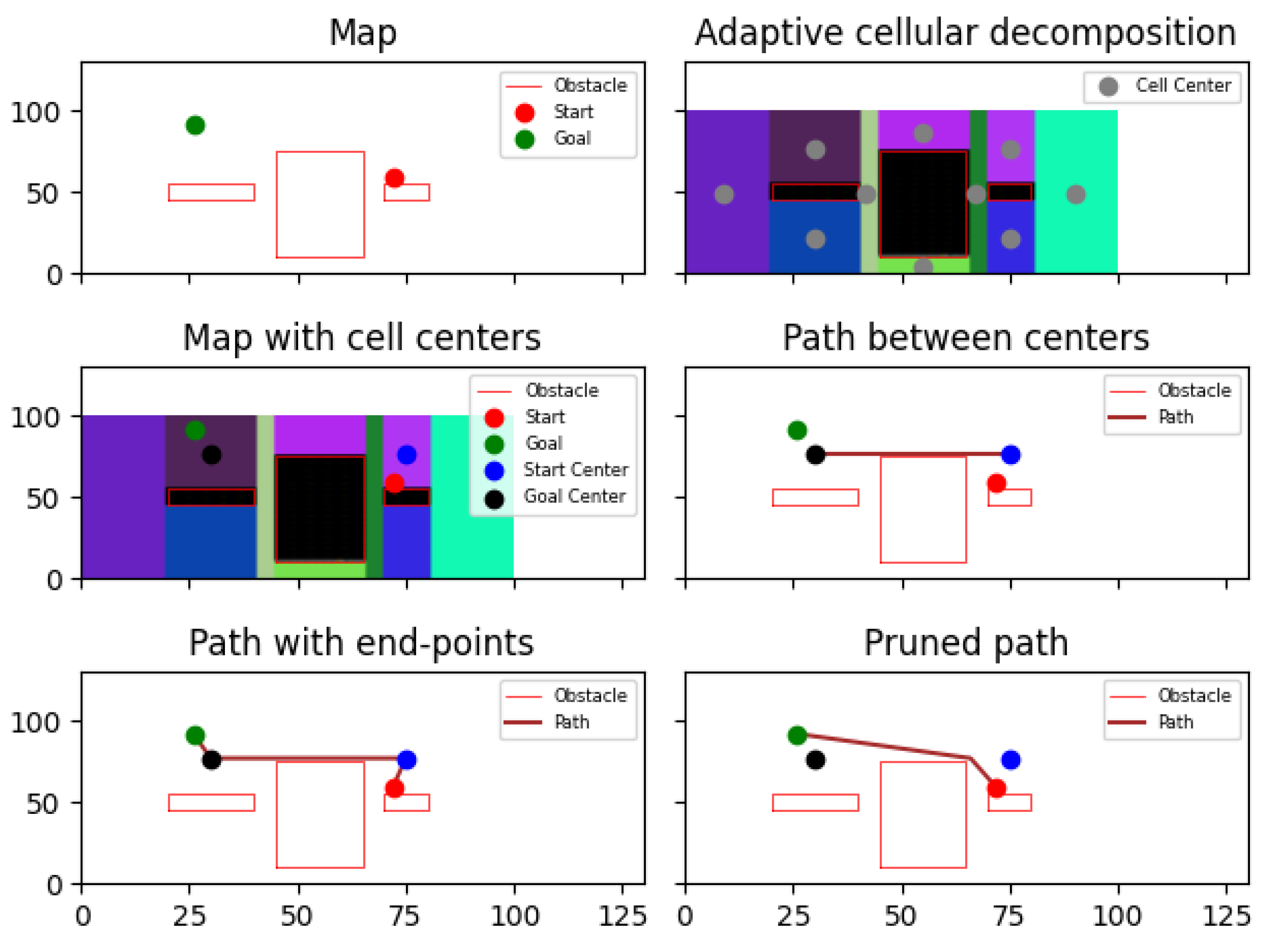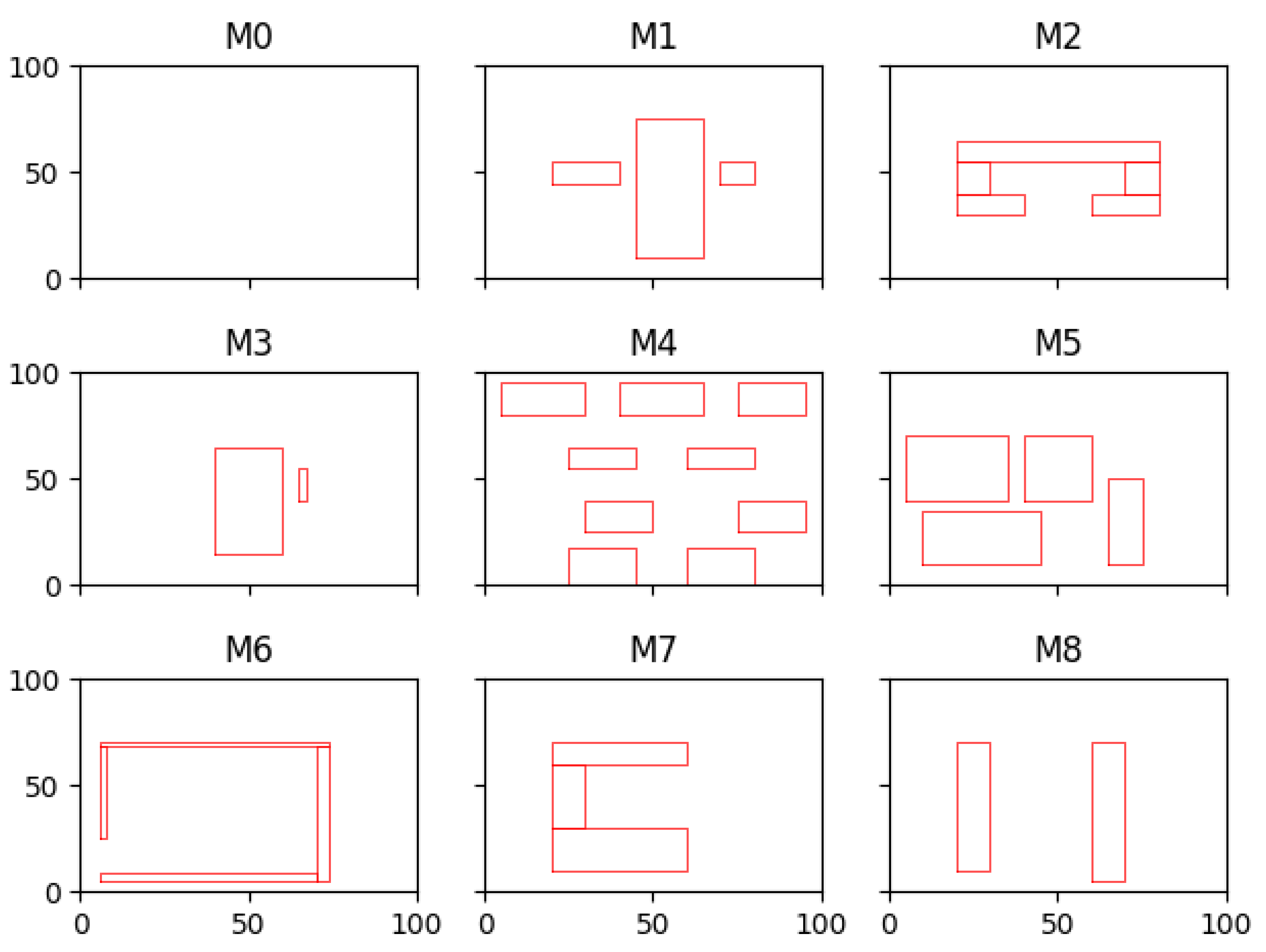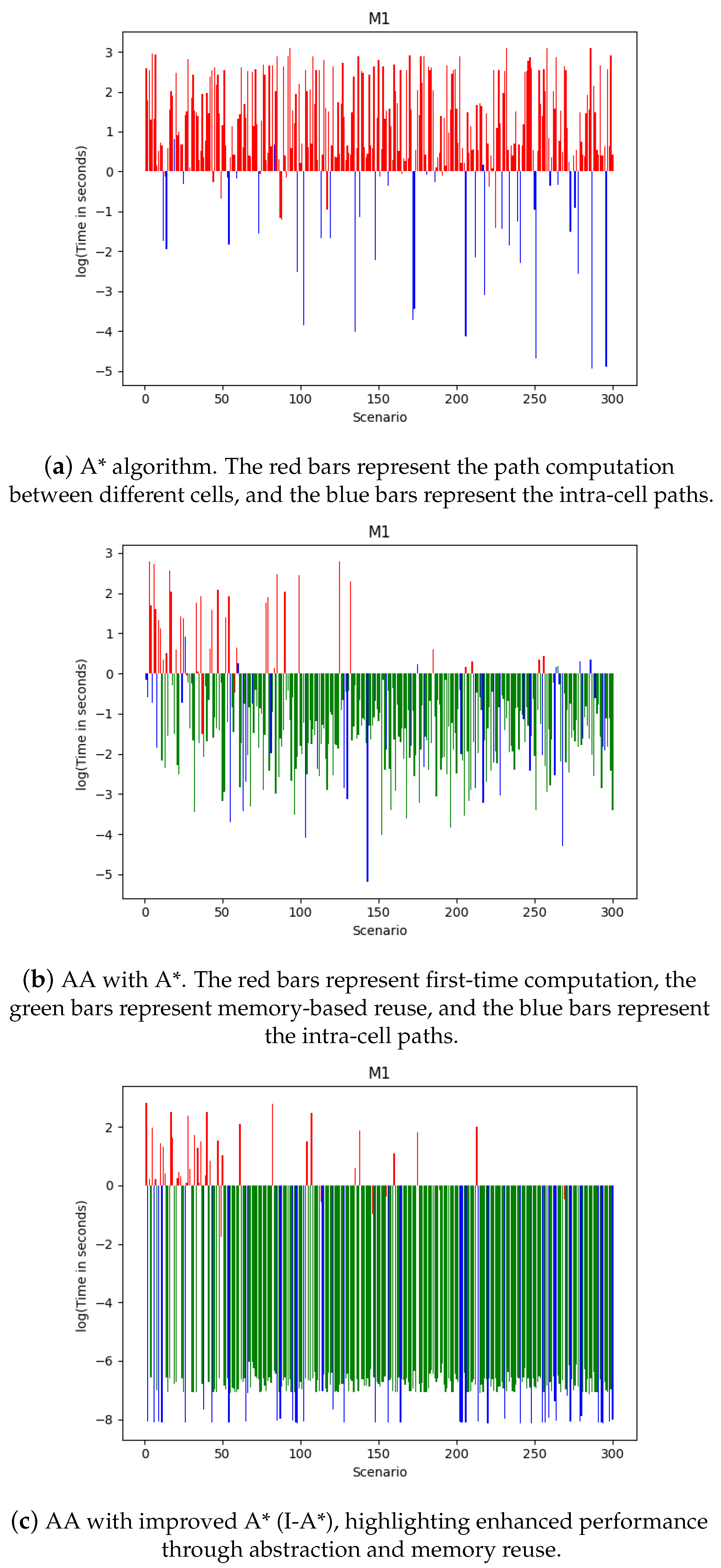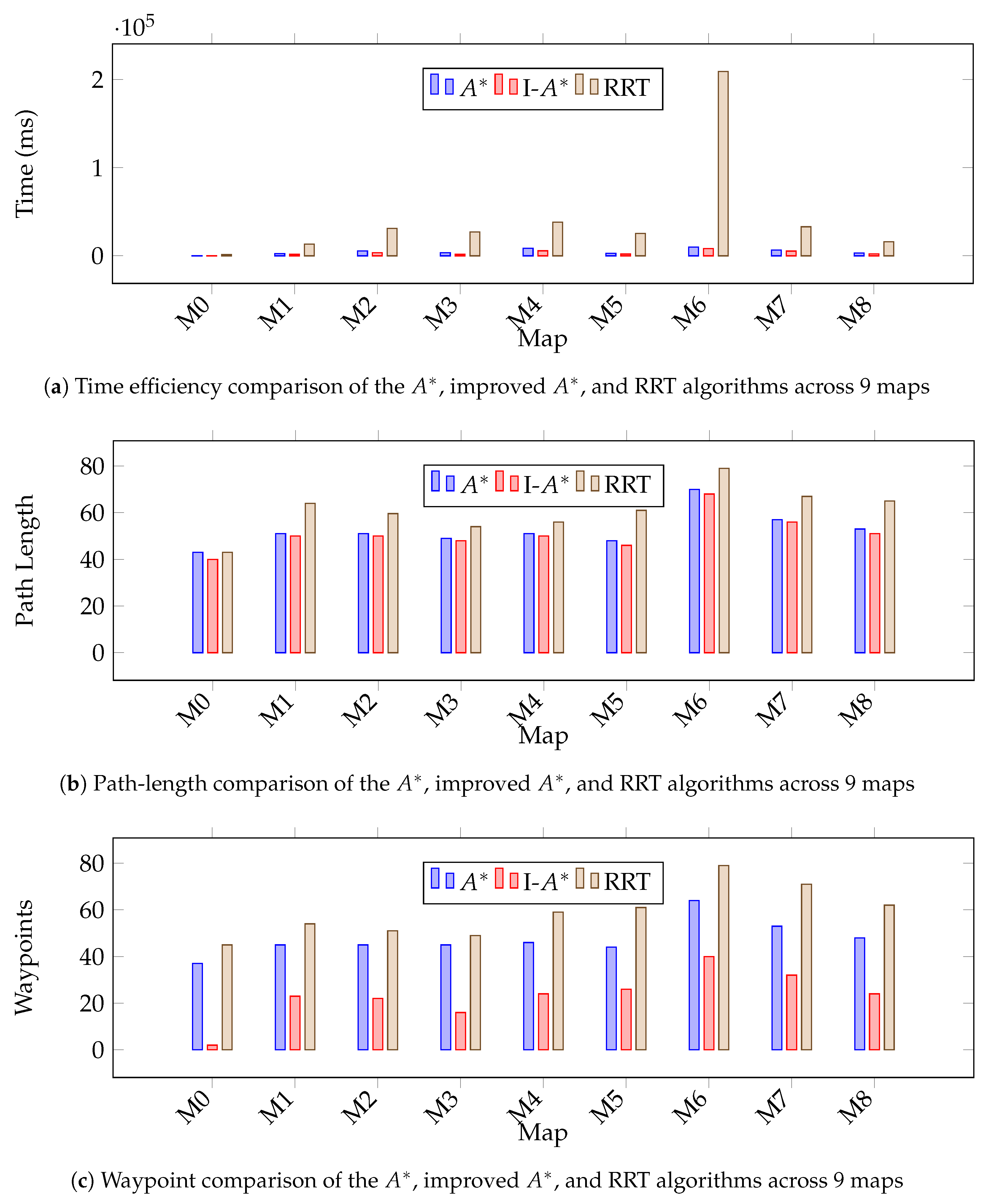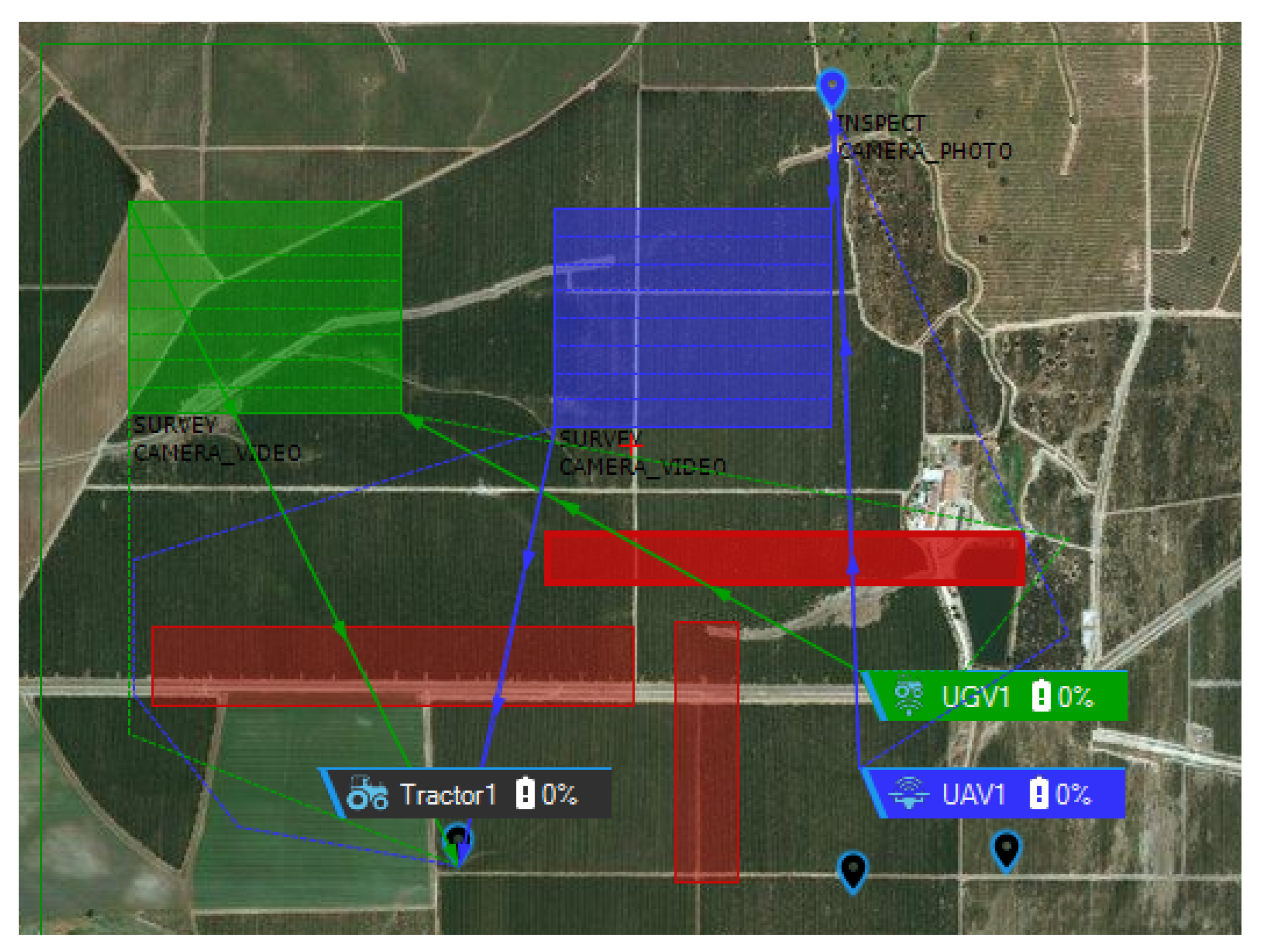1. Introduction
Advancements in mobile robot technologies have paved the way for their adoption in various everyday applications, such as agriculture, construction, surveillance, and transportation [
1,
2,
3,
4]. Path planning is a crucial aspect of mobile robots, serving as the backbone of their ability to autonomously navigate from one point to another for the execution of specific tasks. This is important for finding the shortest and most efficient path in the shortest amount of time [
5]. For a mobile robot to navigate, it requires a map that includes the details of obstacles, as well as its current and goal locations.
Currently, path-planning algorithms are divided into three main categories: data-driven learning-based (DDLB) algorithms [
1,
2,
6,
7], memory-based (MB) algorithms [
8,
9], and sample-based (SB) algorithms [
10]. DDLB algorithms, which leverage machine learning to optimize pathfinding, might face difficulties in generalizing across diverse environments. Specifically, an algorithm developed in one setting might not perform effectively when applied in a different environment, as DDLB heavily relies on the quality and quantity of available data. If the data is incomplete, inaccurate, or biased, it can lead to suboptimal or even unsafe path-planning decisions [
1,
2,
11,
12]. DDLB algorithms cannot learn in real time from the environment, which limits their adaptability in complex and unpredictable situations [
2,
13]. Some DDLB algorithms can be computationally intensive, especially when dealing with large datasets or complex environments. This can result in increased planning times, which may not be acceptable in real-time applications or resource-constrained systems [
14]. DDLB models are prone to overfitting, where they learn to memorize the training data instead of capturing the underlying patterns. This can result in poor performance when deployed in real-world scenarios that differ from the training data [
2,
15].
MB algorithms, which rely on stored experiences and knowledge for decision-making, can store a subset of the environment’s information. This can result in incomplete representations of the environment, leading to navigation failures or suboptimal paths, especially in large or complex environments [
16]. Memory constraints may require the use of compression techniques or simplified representations to accommodate the available memory. This compression can lead to information loss, reducing the accuracy of the environment representation and potentially compromising navigation performance [
8]. Algorithms designed for memory-limited path planning may require additional computational resources to manage memory usage efficiently. This could result in longer planning times, limiting the feasibility of real-time navigation in dynamic environments or scenarios that require rapid decision-making [
9]. The limitations of MB approaches include a risk of information loss due to compression, the need for additional planning time, and potential challenges in handling large environments.
In SB path-planning algorithms, the map is divided into a set of nodes [
17] and edges [
18]. Each node represents a certain part of the map, and path planning is achieved on such a set by considering how the nodes connect. In rapidly exploring random tree star (RTT*), which is a type of SB [
10], the algorithm finds a path between the starting point and goal point by introducing nodes randomly and rewiring them at each step to ensure that the minimum path length reaches the goal position [
17].
, which is also a type of SB [
18], is one of the best path-planning algorithms. It explores the available space in the direction of the goal by taking small steps.
outperforms RTT* and many other path-planning algorithms [
19]. The best route from the starting point to the goal is often obstacle-free [
2].
, RTT, and RTT* can find the shortest path, but they work best in open environments. However, finding a new path from the robot’s current position to the goal can be natural but very inefficient. This inefficiency occurs because the same path exploration is repeated multiple times during calculations.
This paper proposes a path-planning algorithm with the adaptive autonomy (AA) concept based on dynamic programming, I-A*, and adaptive cellular decomposition. It offers a promising solution to overcome the limitations inherent in three types of path-planning algorithms.
6. Conclusions and Future Work
In this paper, we have introduced a path-planning algorithm with adaptive autonomy (AA). The algorithm incorporates an improved form of , referred to as I-, which assesses the feasibility of a direct path to the goal from the current position during execution. The execution time comparison chart highlights the effectiveness of AA in reducing the number of path calculations and improving efficiency compared to the traditional algorithm. Both AA with and AA with I-A* demonstrate significant reductions in path calculations between different cells. Moreover, the use of memory for path calculations leads to additional efficiency gains. The average execution times and standard deviations indicate the improved performance and consistency achieved by the AA approaches, with AA using dynamic programming and I-A* showing the highest level of efficiency.
We conducted practical testing of the proposed algorithm in an actual agricultural context to assess its effectiveness, and the findings are quite promising. The algorithm successfully computes dashed-line paths that adeptly navigate around red square obstacles, showcasing its ability to avoid obstacles effectively, as shown in
Figure 6. While our adaptive cellular decomposition method is capable of handling non-convex obstacles, as shown in our tests, future work will involve more rigorous testing on a wider variety of complex maps with highly irregular and non-orthogonal obstacle shapes to further validate its robustness and efficiency.
Future work will focus on extending and enhancing the proposed framework in several critical dimensions to improve its practicality, adaptability, and performance. First, we aim to conduct comprehensive and rigorous evaluations of the system across a broader range of complex and realistic environments. These environments will include maps with intricate layouts and highly irregular, non-orthogonal obstacle geometries to assess the robustness and generalization capabilities of the cellular decomposition method under diverse spatial constraints. Special attention will be given to testing in environments where traditional grid-based decomposition techniques tend to fail or become computationally expensive.
Second, a key direction involves adapting the algorithm for operation in dynamic and partially known environments. This includes integrating real-time sensory inputs, such as LiDAR or camera-based SLAM, to detect and classify previously unknown or moving obstacles. To maintain efficient path planning under such conditions, we will develop strategies for incremental map updates and localized path replanning, minimizing the need to recompute the full path from the start. This will enhance the system’s responsiveness and enable real-time autonomy in cluttered, unpredictable domains.
Furthermore, we plan to explore the scalability and extension of the framework to 3D environments, which are vital for aerial drones, underwater vehicles, and mobile manipulators. This transition from 2D to 3D introduces challenges in decomposition, memory storage, and path planning due to increased computational complexity and the need for three-dimensional obstacle avoidance. We will investigate how the adaptive decomposition method can be reformulated in 3D space while preserving its efficiency and modularity.
Lastly, another promising research direction is the deployment of this framework in multi-robot systems, where collaboration and conflict resolution are essential. In such systems, we will focus on decentralized planning architectures, enabling each agent to independently access and utilize precomputed inter-cell paths for coordination. We aim to design efficient mechanisms for communication, shared memory access, and dynamic task allocation, ensuring robust operation even in partially connected networks. This would enable robots to collaboratively explore, map, and act within complex environments while avoiding collisions and maximizing overall mission efficiency.
Author Contributions
Conceptualization, M.A.; methodology, M.A.; software, M.A.; validation, M.A. and M.Z.B.; formal analysis, M.A.; investigation, M.A.; resources, M.A.; data curation, M.A.; writing—original draft preparation, M.A. and M.Z.B.; writing—review and editing, M.A., M.Z.B., U.A. and A.R.; visualization, M.A. and M.Z.B.; supervision, M.Z.B.; project administration, M.A.; All authors have read and agreed to the published version of the manuscript.
Funding
This research received no external funding.
Data Availability Statement
The data presented in this study are available on request from the corresponding author.
Conflicts of Interest
The authors declare no conflicts of interest.
References
- Mehmet, G. Dynamic Path Planning via Dueling Double Deep Q-Network (D3QN) with Prioritized Experience Replay. Appl. Soft Comput. 2024, 158, 111503. [Google Scholar]
- Aatif, M.; Adeel, U.; Basiri, A.; Mariani, V.; Iannelli, L.; Glielmo, L. Deep Learning Based Path-Planning Using CRNN and A* for Mobile Robots. In Proceedings of the International Conference on Interactive Collaborative Robotics, Baku, Azerbaijan, 25–29 October 2023; Springer: Cham, Switzerland, 2023; pp. 118–128. [Google Scholar]
- LaValle, S.M. Planning Algorithms; Cambridge University Press: Cambridge, UK, 2006. [Google Scholar]
- Yao, M.; Zhao, M. Unmanned aerial vehicle dynamic path planning in an uncertain environment. Robotica 2015, 33, 611–621. [Google Scholar] [CrossRef]
- Pretto, A.; Aravecchia, S.; Burgard, W.; Chebrolu, N.; Dornhege, C.; Falck, T.; Fleckenstein, F.; Fontenla, A.; Imperoli, M.; Khanna, R.; et al. Building an Aerial-Ground Robotics System for Precision Farming. arXiv 2019, arXiv:1911.03098. [Google Scholar]
- Tamar, A.; Wu, Y.; Thomas, G.; Levine, S.; Abbeel, P. Value iteration networks. arXiv 2016, arXiv:1602.02867. [Google Scholar]
- Xiao, Z.; Wan, H.; Zhuo, H.H.; Lin, J.; Liu, Y. Representation learning for classical planning from partially observed traces. arXiv 2019, arXiv:1907.08352. [Google Scholar]
- Mourikis, A.I.; Roumeliotis, S.I. A multi-state constraint Kalman filter for vision-aided inertial navigation. In Proceedings of the 2007 IEEE International Conference on Robotics and Automation, Rome, Italy, 10–14 April 2007; pp. 3565–3572. [Google Scholar]
- Borenstein, J.; Koren, Y. The vector field histogram-fast obstacle avoidance for mobile robots. IEEE Trans. Robot. Autom. 1991, 7, 278–288. [Google Scholar] [CrossRef]
- Noreen, I.; Khan, A.; Habib, Z. Optimal path planning using RRT* based approaches: A survey and future directions. Int. J. Adv. Comput. Sci. Appl 2016, 7, 97–107. [Google Scholar] [CrossRef]
- Stachniss, C.; Grisetti, G.; Burgard, W. Information gain-based exploration using rao-blackwellized particle filters. In Proceedings of the Robotics: Science and Systems, Cambridge, MA, USA, 8–11 June 2005; Volume 2, pp. 65–72. [Google Scholar]
- Pathak, D.; Agrawal, P.; Efros, A.A.; Darrell, T. Curiosity-driven exploration by self-supervised prediction. In Proceedings of the International Conference on Machine Learning, PMLR, Sydney, Australia, 6–11 August 2017; pp. 2778–2787. [Google Scholar]
- Richter, S.R.; Vineet, V.; Roth, S.; Koltun, V. Playing for data: Ground truth from computer games. In Computer Vision–ECCV 2016, Proceedings of the 14th European Conference, Amsterdam, The Netherlands, 11–14 October 2016; Proceedings, Part II; Springer: Cham, Switzerland, 2016; pp. 102–118. [Google Scholar]
- Mellinger, D.; Kumar, V. Minimum snap trajectory generation and control for quadrotors. In Proceedings of the 2011 IEEE International Conference on Robotics and Automation, Shanghai, China, 9–13 May 2011; IEEE: Piscataway, NJ, USA, 2011; pp. 2520–2525. [Google Scholar]
- Thrun, S.; Hahnel, D.; Ferguson, D.; Montemerlo, M.; Triebel, R.; Burgard, W.; Baker, C.; Omohundro, Z.; Thayer, S.; Whittaker, W. A system for volumetric robotic mapping of abandoned mines. In Proceedings of the 2003 IEEE International Conference on Robotics and Automation (Cat. No.03CH37422), Taipei, Taiwan, 14–19 September 2003; Volume 3, pp. 4270–4275. [Google Scholar] [CrossRef]
- Hsu, D.; Kindel, R.; Latombe, J.C.; Rock, S. Randomized kinodynamic motion planning with moving obstacles. Int. J. Robot. Res. 2002, 21, 233–255. [Google Scholar] [CrossRef]
- Melchior, N.A.; Simmons, R. Particle RRT for path planning with uncertainty. In Proceedings of the 2007 IEEE International Conference on Robotics and Automation, Rome, Italy, 10–14 April 2007; IEEE: Piscataway, NJ, USA, 2007; pp. 1617–1624. [Google Scholar]
- Hart, P.E.; Nilsson, N.J.; Raphael, B. A formal basis for the heuristic determination of minimum cost paths. IEEE Trans. Syst. Sci. Cybern. 1968, 4, 100–107. [Google Scholar] [CrossRef]
- Lerner, J.; Wagner, D.; Zweig, K. Algorithmics of Large and Complex Networks: Design, Analysis, and Simulation; Springer: Berlin/Heidelberg, Germany, 2009; Volume 5515. [Google Scholar]
- Scerri, P.; Reed, N. Designing Agents for Systems with Adjustable Autonomy; Citeseer: University Park, PA, USA, 2001. [Google Scholar]
- Zieba, S.; Polet, P.; Vanderhaegen, F.; Debernard, S. Principles of adjustable autonomy: A framework for resilient human–machine cooperation. Cogn. Technol. Work 2010, 12, 193–203. [Google Scholar] [CrossRef]
- Schroeder de Witt, C.A.; Foerster, J.N.; Farquhar, G.; Torr, P.H.; Boehmer, W.; Whiteson, S. Multi-agent common knowledge reinforcement learning. arXiv 2018, arXiv:1810.11702. [Google Scholar]
- Peysakhovich, A.; Kroer, C.; Lerer, A. Robust multi-agent counterfactual prediction. In Proceedings of the Advances in Neural Information Processing Systems, Vancouver, BC, Canada, 8–14 December 2019; pp. 3077–3087. [Google Scholar]
- Kim, C.; Kim, C. Development of autonomous driving and motion control system for a patient transfer robot. Actuators 2023, 12, 106. [Google Scholar] [CrossRef]
- Wang, T.; Li, A.; Guo, D.; Du, G.; He, W. Global dynamic path planning of agv based on fusion of improved a* algorithm and dynamic window method. Sensors 2024, 24, 2011. [Google Scholar] [CrossRef]
- Zhang, S.; Zhao, T. Mobile robot path planning in 2d space: A survey. Highlights Sci. Eng. Technol. 2022, 16, 279–289. [Google Scholar] [CrossRef]
- Zhang, H.; Tao, Y.; Zhu, W. Global path planning of unmanned surface vehicle based on improved a-star algorithm. Sensors 2023, 23, 6647. [Google Scholar] [CrossRef] [PubMed]
- Zheng, C.; Kuang, M. Scouting robot with search-space reducing hybrid networks for unknown environment path planning. J. Stud. Res. 2023, 12, 1–12. [Google Scholar] [CrossRef]
- Li, Y.; Li, J.; Zhou, W.; Yao, Q.; Nie, J.; Qi, X. Robot path planning navigation for dense planting red jujube orchards based on the joint improved a* and dwa algorithms under laser slam. Agriculture 2022, 12, 1445. [Google Scholar] [CrossRef]
- Wesson, J.A. Sawtooth oscillations. Plasma Phys. Control. Fusion 1986, 28, 243. [Google Scholar] [CrossRef]
- Yang, K. Anytime synchronized-biased-greedy rapidly-exploring random tree path planning in two dimensional complex environments. Int. J. Control Autom. Syst. 2011, 9, 750–758. [Google Scholar] [CrossRef]
- Tang, S.H.; Yeong, C.F.; Su, E.L.M. Comparison between Normal Waveform and Modified Wavefront Path Planning Algorithm for Mobile Robot. Appl. Mech. Mater. 2014, 607, 778–781. [Google Scholar] [CrossRef]
- Botea, A.; Müller, M.; Schaeffer, J. Near optimal hierarchical path-finding. J. Game Dev. 2004, 1, 1–30. [Google Scholar]
| Disclaimer/Publisher’s Note: The statements, opinions and data contained in all publications are solely those of the individual author(s) and contributor(s) and not of MDPI and/or the editor(s). MDPI and/or the editor(s) disclaim responsibility for any injury to people or property resulting from any ideas, methods, instructions or products referred to in the content. |
© 2025 by the authors. Licensee MDPI, Basel, Switzerland. This article is an open access article distributed under the terms and conditions of the Creative Commons Attribution (CC BY) license (https://creativecommons.org/licenses/by/4.0/).
